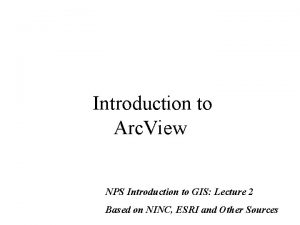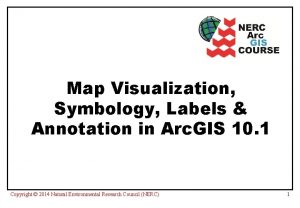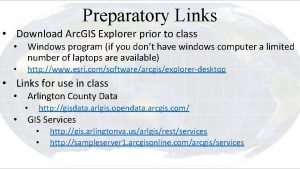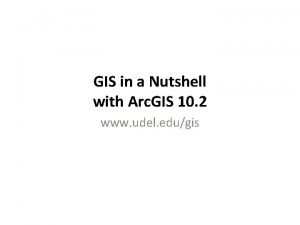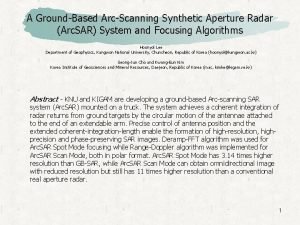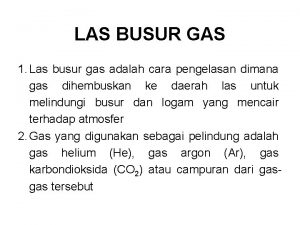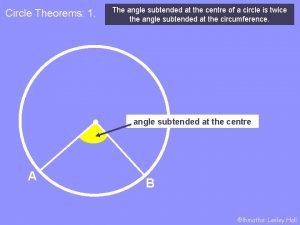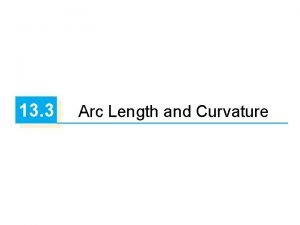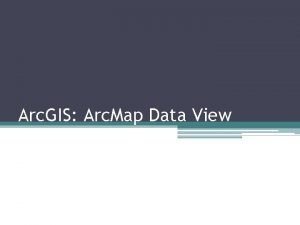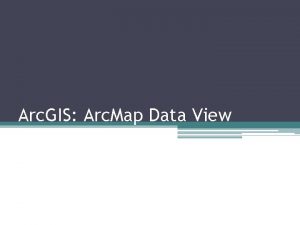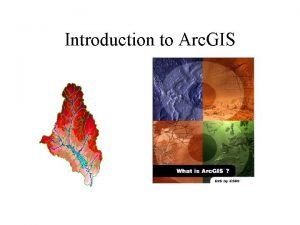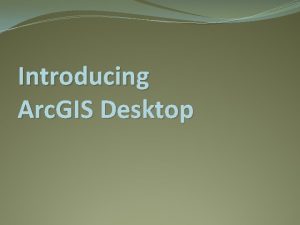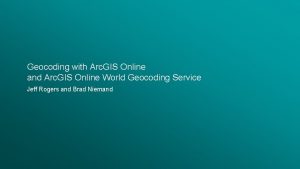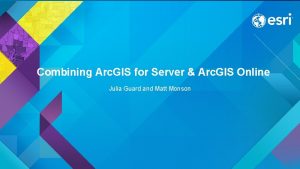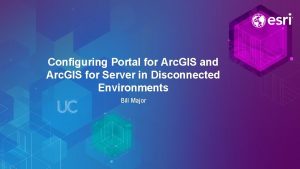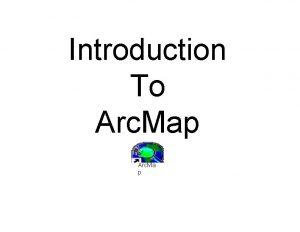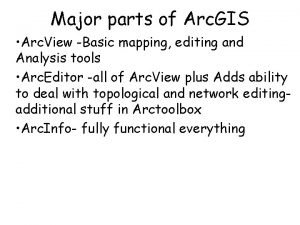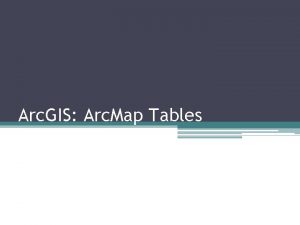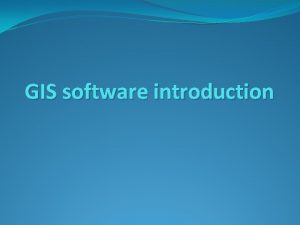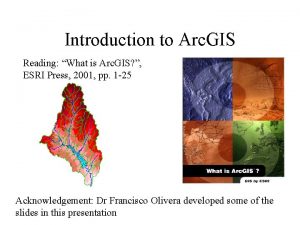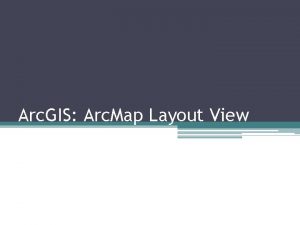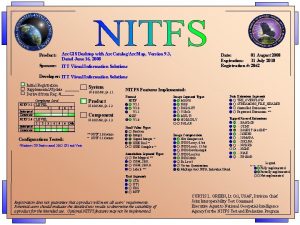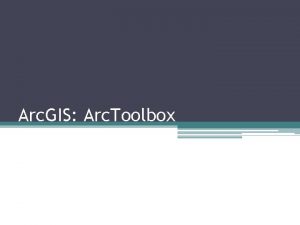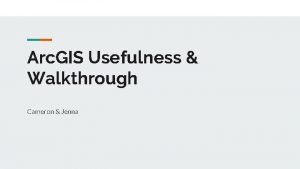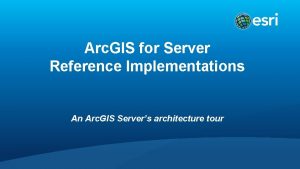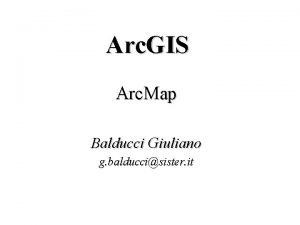GIS in a Nutshell with Arc GIS 10













































- Slides: 45

GIS in a Nutshell with Arc. GIS 10. 2 www. udel. edu/gis

What is GIS Definition – GIS = Geographic Information Systems: system used to create, store, edit, analyze, format, and deliver data related to geographic location • Systems = hardware, software, methods

Geographic Information What is GIS Ad Hoc • Data with “geographic component”

Geographic Information What is GIS Formal • … in geographic context

Geographic Information What is GIS? Layers

Geographic Information What is GIS Geographic Reference • Geographic Referencing (“Georeferencing”) of information by geographic coordinates (latitude and longitude) • Unprojected coordinates are usually in decimal degrees like 39. 679167, -75. 758056 • Projected coordinates are expressed in relation to a flat plane, in familiar distance units like 18 S 434990 meters 4392423 meters

What is GIS? Primary Data Types Vector Raster • Store x, y coordinates to • In a grid, cell values represent locations and represent the dominant boundaries of map features characteristic of that cell • Point (x, y), line [(x, y), … ], polygon [(x, y), … ] Lines Polygons Points

What is GIS Common Data formats • • Shapefile (. shp, shx. , . dbf, . prj) File geodatabase (. gdb) Personal geodatabase (. mdb) Various imagery files (. img, . tif, . sid, . jp 2, . asc, . hdr, GRID (directory)) • Common generic geographic data formats (. csv, . xls, . txt (tab-delimited), etc. , or nongeoreferenced images) • Map Document IS NOT DATA (. mxd)

Visualization What is GIS? Examples Reference

Visualization What is GIS? Examples Thematic

Visualization What is GIS? Examples Charts

Visualization What is GIS? Examples Web/Interactive

Visualization What is GIS? Examples 3 D

Visualization What is GIS? Examples Animation

Analysis What is GIS? Examples Networks and Movement

Analysis What is GIS? Examples Imagery/ Remote Sensing

Analysis What is GIS? Examples Volumetric

Analysis What is GIS? Examples Proximity

Analysis What is GIS? Examples Tables and Reports

Arc. GIS Introduction – Arc. GIS is the most popular GIS software in the world – It is a powerful suite of tools, which satisfies the largest variety of use cases – It is a propriety software developed by Esri, and licensed to UD, other software available

What is GIS Activity • How do you envision GIS being used in your job area (department, center, field)?

Arc. GIS Software Arc. Map Arc. Catalog

Arc. GIS Arc. Map Startup

Arc. GIS Arc. Map Data Frame Editor Toolbar Menu Bar Standard Toolbar Tools Toolbar Table of Contents/ Data Sources/ Selection/ Visibility Pane (Right Click) Context Menu Data Frame/ Layout Toggle

Arc. GIS Arc. Map Table of Contents Pane Toggle Table of Contents/ Data Sources/ Selection/ Visibility Pane Turn layers On/off with checkbox Change layer Drawing order By moving up/down

Arc. GIS Arc. Map Toolbars

Arc. GIS Arc. Map Attribute Table

Arc. GIS Add Data • You can add pre-map web basemaps from this button, before you browse to local data • “ Connect To Folder” to connect to data outside of home directory. After you’ve entered the Add Data dialog, you must click the Connect To Folder button to browse to that location

Arc. GIS Activity • Download and extract the data from http: //www. udel. edu/002013 • Open • Add all data layers to map • Rename “us_counties” to “Counties” • Explore Counties map layer attribute table

Arc. GIS Symbology

Arc. GIS Arc. Map Layout Frame Insert Menu Layout Frame Data/Layout Toggle Layout Toolbar

Arc. GIS Export Image, Print, and Saving • You can “Export Map” to an image file or “Print” from the File menu. • You can save the map document, which contains pointers to your data and your map styles, by selecting “Save” from the File menu. If your system changes your data may not be located.

Arc. GIS Activity • Change symbology of Counties layer to show ratio of Female (Value) to Male (Normalization) population. • Switch to the layout frame. Experiment with adding map elements (you may want to try a title or a legend, for instance). • Export the map as a graphic. . png is best. • Save work. • If you have extra time, try experimenting with different symbologies and improving your layout

Arc. GIS Identify

Arc. GIS Selection Tools

Arc. GIS Setting Selectable Layers • Indicate which layers you want to be able to select features from interactively by viewing TOC as List by Selection • Toggle layers as Selectable or Not Selectable by clicking • Displays selectable layers and number of features selected (in this example, zero for all layers)

Arc. GIS Calculating Statistics

Arc. GIS Activity • Select by Attribute, from Counties, name = ‘New Castle’ • Select by Location, select where intersecting selection (New Castle) • Find statistics of selection (counties intersecting New Castle) • If you have extra time, try this activity on a county that interests you and compare the results

Arc. GIS Join • Add your non-GIS data file. It might be saved as a spreadsheet file • Right-click on the GIS layer with a common location field as the non-GIS (e. g. , state name) from data Joins and Relates, Join. • Select the common fields from the Join dialog • Now that the data is joined, you can change the symbology to switch to one of your new fields

Arc. GIS Export Data • You can select a feature or a set of features to export only those to a new shapefile/layer • Export data from the Data contextual menu on the layer of interest

Arc. GIS Activity • Remove all layers • Add a basemap from the Add Layers button • Add non-georeferenced location-based data (west. Nile. csv) to the map • Add a related GIS layer to the map • Do a standard join • Export as a new shapefile • If you have extra time, try with your own data from the web or try an improved layout to print or export

Arc. GIS Gotchas • The map document (. mxd) file does not contain your data! It just references it • A shapefile is really a collection of files that must be kept together • Make a new folder for every new project. Keep all map documents and data in this directory. This is a good way to stay organized and Arc. GIS’s internal shortcuts will be automatically relevant. • Create a file geodatabase in the project folder. Make this the default geodatabase for this map document and all subsequent for the project. Otherwise your new layers will be written to Default. gdb which gets cluttered and data may be lost on a shared system • Do not use spaces or other special characters (except the underscore character) when naming any file or folder. I recommend you use lowercase letters, digits and the underscore character only! • Under File--Map Document properties, check the "Store Relative Pathnames" box. Then when you end a work session, you can "save" the state of your session as a Map Document (MXD) file on your USB drive. • New data frame automatically matches first layer subsequent layers usually reprojected In part, from http: //www. udel. edu/johnmack/apec 480/480 lab 1. html

Review Activity • Real-world examples of vector data? • Real-world examples of raster data? • Example of how you would use the Select by Attributes tool to solve a problem • Example of how you would use the Select by Location tool to solve a problem • Do you have data that you’d like to view in a map that isn’t GIS data? • How could the statistics tool be used to solve a problem?

To learn more • Tooltips • Arc. GIS Help menu • www. udel. edu/gis/learn – Esri Virtual Campus • http: //resources. arcgis. com/

Questions? • www. udel. edu/gis • consult@udel. edu thanks to FEMA for allowing us to reuse some slide content
 Photosynthesis in a nutshell
Photosynthesis in a nutshell Tenses in a nutshell
Tenses in a nutshell Bfs in a nutshell
Bfs in a nutshell Web design in a nutshell
Web design in a nutshell Itil in a nutshell
Itil in a nutshell Maths in a nutshell
Maths in a nutshell Attention
Attention Grammar in a nutshell
Grammar in a nutshell How to write links in apa format
How to write links in apa format History of the world in a nutshell
History of the world in a nutshell Arc emu88 com arc info 47 100047 html
Arc emu88 com arc info 47 100047 html Arc promoteur vs arc investigateur
Arc promoteur vs arc investigateur Minor arc and major arc
Minor arc and major arc Minor arc of a circle
Minor arc of a circle Arc hydro gis for water resources
Arc hydro gis for water resources Arc gis
Arc gis Arc view gis
Arc view gis Arc gis
Arc gis Arc gis map
Arc gis map Arc gis explorer
Arc gis explorer Gis
Gis Arc gis 10
Arc gis 10 Simbol arc
Simbol arc Arc.sar
Arc.sar Bonjour bon voyage
Bonjour bon voyage Chapter 12 flux cored arc welding
Chapter 12 flux cored arc welding Arc shot
Arc shot Las busur rendam
Las busur rendam Arc length welding definition
Arc length welding definition Island arc picture
Island arc picture Scapular movements
Scapular movements What is the correct sequence in a typical reflex arc
What is the correct sequence in a typical reflex arc Homework 4 congruent chords and arcs
Homework 4 congruent chords and arcs Smaw
Smaw Subdeltoid bursitis
Subdeltoid bursitis Juan de fuca ridge
Juan de fuca ridge Angles subtended by the same arc
Angles subtended by the same arc Arc elasticity of demand
Arc elasticity of demand Arc length and curvature
Arc length and curvature Tkinter arc
Tkinter arc Volcanic island arc
Volcanic island arc Shielded metal arc welding safety
Shielded metal arc welding safety Tamponada cardiaca dex
Tamponada cardiaca dex Circumference
Circumference Pearson
Pearson Eddie adams arc flash
Eddie adams arc flash
















